|
Home
Glossary
Science
of
Keris
Agenda
Keris
Books
Java
Keris Contact
FAQ
Tips
Java Keris Mailing List
Keris
Links
Guest Book
Keris
Encyclopaedia
|
Keris Glossary
Some terms
needs to be understood for everyone interested in learning about keris.
Without the understanding, one can get difficulties in the process
of learning of the keris. The terms of keris are mostly known in Java,
such as: dapur, pamor, tangguh, tanjeg, angsar, perabot, etc.
Below are
mostly short description of keris terms which are common in Java and
Madura.
Angsar
is the power of magic or 'force' that some people believe is in the
blade of keris. This power of magic or 'force' is not visible, but can
be felt by one who believe in it. Angsar
can be good or bad.
Basically all keris has good angsar, but sometimes a good
angsar is not
suitable to everybody. For example a Keris which has a good angsar
for a
soldier, almost always is not suitable for a businessman. Another
example is a Keris that has a good angsar
for a leader is not suitable
for lower rank salaryman.
To understand the angsar
of a keris, one needs the practice and
knowledge of tanjeg. To understand if someone is suitable to the
angsar of a keris, the practice and knowledge of
tayuh is
used.
Dapur
is a term for the name of shape or type of the blade of a keris.
With the mention of the dapur of the keris, one will understand the
shape of the keris mentioned. E.g. one says "The Keris has the
dapur of Tilam Upih" , the listener will understand that the keris
was a straight one, not a luk one. Another example is when the dapur is
Sabuk Inten, then it must be an eleven luk keris.
In the Javenese culture of Keris, it is known more than 145 dapur keris.
But from that number, only 120 are considered dapur keris that are
'right' or following the rule (pakem). Serat Centini, which is
considered as the guide of pakem (rule) of dapur keris, specify
the dapur of keris as follow:
Straight
keris has 40 variety of dapur. Keris that has 3 luk, 11
dapur. Keris
with 5 luk, 12 dapur. Keris with 7 luk, 8
dapur. Keris with 9 luk, 13
dapur. Keris with 11 luk, 10
dapur. Keris with 13 luk, 11
dapur. Keris
with 15 luk, 3 dapur. Keris with 17 luk, 2
dapur. Keris with 19 luk to
29 luk each has 1 dapur.
Alternatively
according the manuscript Sejarah Empu, written by Pangeran (Prince)
Wijil, the number of dapur that is considered following pakem is much
more than those mentioned above. The manuscript wrote that straight
keris has 44 variety of dapur. Luk 3 keris has 13
dapur. Luk 11 keris
has 10 dapur. Luk 13 keris has 11
dapur. Luk 15 keris has 6
dapur. Luk
17 keris has 2 dapur. Luk 19 - 29 keris has 2
dapur. Luk 35 keris
has one dapur.
The number of
dapur known until last century is much more than the numbers mentioned
above.
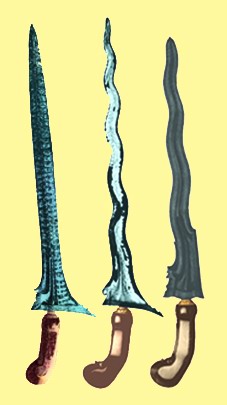
Tangguh
Tangguh literaly meant estimation. In the world of keris, it
means the estimation of the period when the keris blade is made, the
estimation of the creation place of the keris, or the creation style of
the keris. Since it's only estimation, the works of tangguh cannot be
precise. If the keris tangguh is Blambangan, but the really tangguh is a
Majapahit, people will accept the slight error, since the shape of the
two tangguh is similiar. But if a recent keris is being
tangguh a
Jenggala, then it's obvious the one making the estimation is not a good
tangguh expert.
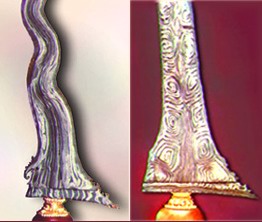
Pamor
Pamor in the keris world has 3 (three) meaning. The first is about the
material of the keris; eg. pamor meteorit (from a meteorit stone),
pamor
Luwu, pamor nikel (from nickel), and
pamor sanak. The second meaning is
about the shape of the blade, eg. pamor Ngulit
Semangka, Beras Wutah, Ri
Wader, Adeg, etc. The third and last meaning is about the technic of the
making of the keris, eg. pamor mlumah,
pamor miring, and
pamor puntiran.

Luk
The term is used for a blade of keris which is not straight but wavy.
The
luk of keris is always odd, never even. The number of
luk starts
from three up to thirteen. This is for a normal keris. If a keris
luk is
more than thirteen, it's an abnormal keris or a
kalawijan or
palawijan
keris.
Mas Kawin
It is simply a term for payment in money or things for a term of
transaction because of change of ownership of a keris, sword or a spear.
The term mas kawin or dowry arise because of the believe that a keris
blade must match with the owner. If it is a match, the owner will gain
fortune, otherwise only misery will come. If someone want to buy a
keris, it is said one propose the owner of the keris, for the keris to
change hand/ownership. Should the mas kawin or dowry is agreed, than the
proposal is accepted, and the keris can change hand.
Mendak
 is a term for the ring of keris, which is the same term in Java, Bali
and Madura. In other region, it is simply called the cincin (ring) of
keris.
Mendak is mostly made of metal: gold, silver, or bronze. Many
mendak is enhanced with diamonds. In the old days, some
mendak is made
of iron with pamor. Beside the function of accesories,
mendak physically
function as divider between the blade and the
warangka.
is a term for the ring of keris, which is the same term in Java, Bali
and Madura. In other region, it is simply called the cincin (ring) of
keris.
Mendak is mostly made of metal: gold, silver, or bronze. Many
mendak is enhanced with diamonds. In the old days, some
mendak is made
of iron with pamor. Beside the function of accesories,
mendak physically
function as divider between the blade and the
warangka.
Pamor
Pamor has three meanings. First is the material in making them; eg.
meteorite pamor, Luwu pamor, nickel pamor, and sanak pamor. Second is
about the shape or style of pamor, eg. ngulit semangka pamor, wos wutah
pamor, ri wader pamor, adeg pamor, etc. Third is about the technique in
making them, eg. mlumah pamor, miring pamor, and puntiran pamor.

From
the wish of the empu, pamor shape is divided again into two categories.
If the empu made the pamor without designing or planning the shape, it
is called pamor tiban. People will consider the pamor as a God's gift.
But if the empu designed or planned the pamor, it called rekan pamor
(rekan from the work
reka = rekayasa = design). Example of
tiban pamor
is wos wutah, ngulit semangka, pulo tirta. Example of the rekan pamor
are udan mas, ron genduru, blarak sinered, and untu walang.

There
is also titipan pamor or
ceblokan pamor, ie pamor which is added later,
after the keris is 90% finished. Shape of pamor is added later in the
late part of the keris making process. Example of titipan pamor are
pamor kul buntet, batu lapak, etc.
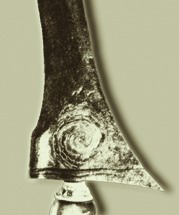 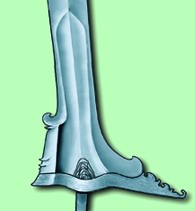
Pendok
function as shield or protection of the gandar part (part
of warangka keris that is made of soft wood). But the function of
protection has changed to a luxury function. A simple pendok is made of
bronze, but the luxury pendok is made of silver or even gold with
diamonds.
The pendok has a few shape, ie bunton pendok, blewehan, slorok and
topengan.
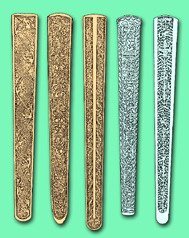
Perabot
The accessories of keris is called perabot of keris. Accessories of
keris include warangka or the sheath of keris, ukiran or the handle of
keris, mendak or the ring of keris, selut or pedongkok, and
pendok.
Ricikan
is parts or components of a keris blade or spear. Each ricikan keris has
a name. Ricikan keris is important, because of its link with dapur and
tangguh of the keris. A keris with Jalak Sangu Tumpeng dapur has signs
of straight keris, uses gandik polos, pejetan, sogokan rangkap, tikel
alis, and tingil. Gandik polos, pejetan, sogokan rangkap, tikel alis,
and tingil is keris component that is called ricikan.
Selut
like mendak, is made of gold or silver, with diamonds
etched. But the selut only functions as ornament that shows luxury. From
the shape and size, selut is divided into two categories, selut njerut
pecel which is small, and selut njeruk keprok
which is large.
Note: in 2001, selut njeruk keprok with diamonds etched can go for more
than 20 million rupiahs or more than 20.000 US $.
Because it shows too much of luxury, not everyone want to use keris with
selut ornaments.
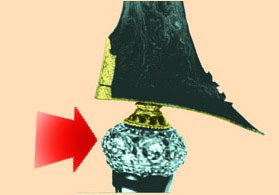
Tangguh
Tangguh simply means estimation. For keris, it means estimation
of the age of the keris, or when the keris is made; where it is
made; or the style of the making of the keris. Since it is only an
estimation, of course it can be wrong. If a keris is said to be tangguh
Blambangan, but really tangguh Majapahit (both are the old kingdoms in
Java), one would forgive the error because the shape of both tangguh are
similiar. But if a new keris is estimated by one as Jenggala, than
clearly one is not a good tangguh expert. Even it is estimation, not
everyone can estimate tangguh keris. For that one must learn from a
tangguh expert, and see many thousands of keris. One must also has a
strong photographic memory.

Tanjeg
is an estimation of the charm or
use of the keris, spear, etc. Some keris enthusiast believe that a keris
has "spirit" that is called angsar. The use of keris is of
many forms, eg. to increase self confidence, to make one advise heard by
others, etc. To understand the use of the angsar, one need the knowledge
of tanjeg.
Tayuh
is an estimation if an angsar
of a keris match with its (to be) owner. Before deciding if a
keris is bought or not (to paid dowry or not), the buyer will have the
keris to be tayuh, to know if the keris match with him or not.
Ukiran
The word ukiran in the terms of keris,
means the hilt. It differs from the standard meaning of carved or
engraved in bahasa Indonesia. The hilt in Balinese keris is called danganan, in Madura it is
landheyan, in Surakarta it is
jejeran, in
Yogyakarta it is deder. While in other areas in Indonesia, Malaysia,
Singapore, and Brunei, it is simply the hilt of the keris.
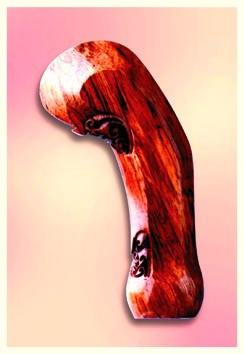
Javakeris use the term
ukiran
and keris hilt considering all regions
above also understand th e term ukiran. The shape of
ukiran
or hilt is
different in every region.
Below is some example of hilt from a few region.
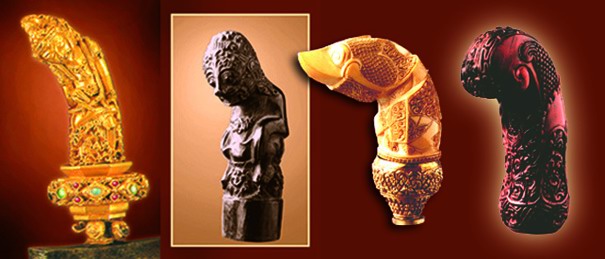
Warangka
Or the sheath of keris, mostly made
of wood which has good texture. In some region, the sheath of keris are
also made from the ivory, buffalo horn, or even old fossil. Keris'
warangka always made beautifully, and sometimes a luxury. That's why
warangka also shows the social economic status of its owner.
The shape of warangka differs from one region to the other. Even in one
region sometimes has different shape of
warangka. The difference made
one easily identify a keris by its region, such as from Bali, Palembang,
Riau, Madura, Jawa, Bugis, Bima or Malaysia.
Some
types of warangka are as follows:
Warangka
Surakarta
Usually
made of cendana wangi wood or cendana Sumbawa wood (sandalwood -
Santalum Album L.) Other options are trembalo wood, and after that
timaha pelet wood. Warangka ladrang can be categorized into four prime
wanda, ie. Ladrang Kasatriyan, Ladrang Kadipaten, Ladrang Capu and
Ladrang Kacir. The last two wanda is rarely made now, and so it becomes
very hard to find.
Warangka
ladrang is warangka that is worn during a ceremony or festivities and
the user is not on duty.
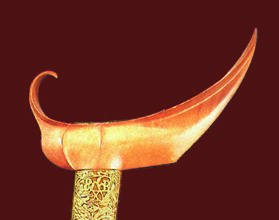
Other
than ladrang, in Surakarta there's also warangka gayaman, which is worn
by one who is on duty in a ceremony or festivities. Eg. in a wedding
ceremony, one who is playing gamelan or the puppet master of the
wayangs. Traditional Javanese kingdom soldier on duty always wore the
warangka gayaman.
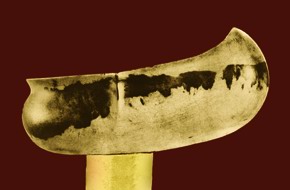
There
are some types of Warangka gayaman Surakarta, such as: Gayaman Gandon,
Gayaman Pelokan, Gayaman Ladrang, Gayaman Bancigan, Gayaman Wayang.
The
third type of warangka is warangka Sandang Walikat. The form is simple
and rather sturdy. Warangka of this type is used when one brings (not
wear) a keris in a trip.

Warangka
Yogyakarta
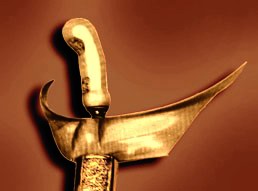 The
shape of warangka in Yogyakarta is rather similiar than Surakarta's, the
difference is in its smaller size, or slimmer. The shape that is
similiar to warangka ladrang in Yogyakarta it's called branggah. The
wood that made the warangka branggah in Yogyakarta is the trembalo or
timaha wood. The use of warangka branggah in Yogyakarta should be the
same as the warangka ladrang in Surakarta, but in recent years that norm
no longer strictly practiced. The
shape of warangka in Yogyakarta is rather similiar than Surakarta's, the
difference is in its smaller size, or slimmer. The shape that is
similiar to warangka ladrang in Yogyakarta it's called branggah. The
wood that made the warangka branggah in Yogyakarta is the trembalo or
timaha wood. The use of warangka branggah in Yogyakarta should be the
same as the warangka ladrang in Surakarta, but in recent years that norm
no longer strictly practiced.
Other shape of warangka Yogyakarta is gayaman. Once, there were more
than eight types of warangka gayaman, but now only two are still
popular, ie. gayaman ngabehan and gayaman banaran. Warangka gayaman is
used when someone is not in attendance of a ceremony.
The third shape of warangka is sandang walikat, which is pretty much the
same shape with the sandang walikat style of Surakarta.
|



 is a term for the ring of keris, which is the same term in Java, Bali
and Madura. In other region, it is simply called the cincin (ring) of
keris.
Mendak is mostly made of metal: gold, silver, or bronze. Many
mendak is enhanced with diamonds. In the old days, some
mendak is made
of iron with pamor. Beside the function of accesories,
mendak physically
function as divider between the blade and the
warangka.
is a term for the ring of keris, which is the same term in Java, Bali
and Madura. In other region, it is simply called the cincin (ring) of
keris.
Mendak is mostly made of metal: gold, silver, or bronze. Many
mendak is enhanced with diamonds. In the old days, some
mendak is made
of iron with pamor. Beside the function of accesories,
mendak physically
function as divider between the blade and the
warangka.










 The
shape of warangka in Yogyakarta is rather similiar than Surakarta's, the
difference is in its smaller size, or slimmer. The shape that is
similiar to warangka ladrang in Yogyakarta it's called branggah. The
wood that made the warangka branggah in Yogyakarta is the trembalo or
timaha wood. The use of warangka branggah in Yogyakarta should be the
same as the warangka ladrang in Surakarta, but in recent years that norm
no longer strictly practiced.
The
shape of warangka in Yogyakarta is rather similiar than Surakarta's, the
difference is in its smaller size, or slimmer. The shape that is
similiar to warangka ladrang in Yogyakarta it's called branggah. The
wood that made the warangka branggah in Yogyakarta is the trembalo or
timaha wood. The use of warangka branggah in Yogyakarta should be the
same as the warangka ladrang in Surakarta, but in recent years that norm
no longer strictly practiced.